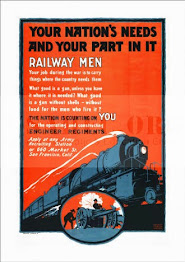Life-Line of the Nation is a short film from the Association of American Railroads and produced by Carl Dudley in the mid-1940s (most likely 1944) that shows how America’s railroads are ensuring the defense of the nation by meeting the transportation needs of a country mobilized for war. The film opens with a shot of a train moving through snowy terrain. Off in the distance, a train goes over a bridge (01:22). There are several shots of various trains moving along tracks. At the U.S. Capitol Building (02:13), members of the military meet with members of Congress to discuss railroad needs in a wartime situation.
People gather around a radio to listen to a broadcast of the attack on Pearl Harbor. Military trucks and tanks are loaded onto trains (03:45); men from every branch of the military board trains as they head out to war. A train moves along the track with snow-covered mountains in the background (04:48). Soldiers and equipment leave the trains and board the ships that will take them overseas (05:20). There are more shots of locomotives. A number of tanks are transported on a train (07:05) Iron ore is loaded onto train cars at a mine (07:18). The iron ore is dumped into barges (07:44). A train hauls coal (08:18); there is a shot of a coal plant. Oil tanker cars are pulled by locomotives (08:59). A newly built ship is sent out onto the water from the shipyard (10:05). There is a shot of the inside of the office of the Association of American Railroads—people diligently work to keep the trains running on time (11:00). There is a series of shots of railcars sporting the different railroad companies’ names and logos. A train crosses the border between the U.S. and Canada (13:34). Various railroad employees work on machining equipment for trains (14:10); men inspect a track. There is a shot of a retired locomotive (15:44), a printing press printing papers (16:55), and various locomotives pulling train cars. One of the final shots of the film is a train passing over a river on a bridge (18:32).







